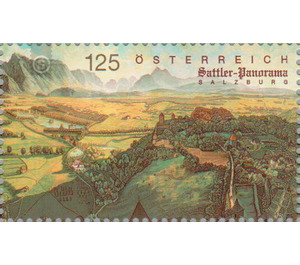art - Austria / II. Republic of Austria 2005 - 125 Euro Cent
Theme: Art & Culture
| Country | Austria / II. Republic of Austria |
| Issue Date | 2005 |
| Face Value | 125.00 |
| Edition Issued | 350,000 |
| Printing Type | combination printing |
| Stamp Type | Commemorative |
| Item Type | Stamp |
| Chronological Issue Number | 1900 |
| Chronological Chapter | OOS-OE2 |
| SID | 15948 |
| In 17 Wishlists | |
The technique of round pictures was invented in the 18th century and the first of its kind was realized by an Irish painter in Edinburgh in 1787. These panoramic images, often up to 15 meters high and over 100 meters wide, became extremely popular in the 19th century, as they were often the only way for people to see foreign cities and countries because the giant paintings traveled criss-crossing Europe. The panorama pictures only lost their meaning through the rapid progress of technology (photography and film) and the change of society. The Sattler Panorama offers a closed picture of the city and the surrounding landscape of the utmost topographical precision and is owned by the Salzburg Museum Carolino Augusteum. It is 4.86 m high and has a circumference of 25.81 m. Johann Michael Sattler, born on September 28, 1786 in Herzogenburg and died on September 28, 1847 in Mattsee studied at the Vienna Academy and worked from 1819 in Salzburg. The idea of painting a panorama of the city of Salzburg probably originated with Emperor Franz I himself. In 1824 Sattler began with the preparatory drawings, taking the view from the Hohensalzburg fortress as a starting point. The painters Friedrich Loos (especially landscapes) and Johann Joseph Schindler (figural representations) also collaborated on the completion of the huge painting. The Panorama was first exhibited in Salzburg in 1829 after its completion. Then Sattler traveled with his family and carpenter 10 years through Europe, mostly on a private houseboat to show the picture in a transportable round temple. This trip helped to make the city's beauty known and laid the foundation for the city's image. Sattler's son Hubert donated the picture to the city of Salzburg in 1870, which had a pavilion built for the circular pictures and cosmoramas in the spa garden, but which was demolished in 1937. 1977 to 2001 you could see the picture again in the casino on Mönchsberg. In place of the former post office 5010, the new home of the Panorama began to emerge in 2003, and in the course of a major renovation, the picture was restored to its original state, as modern technology showed that it has been restored and painted over eight times over the years.


